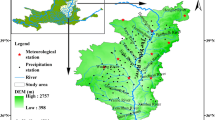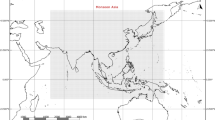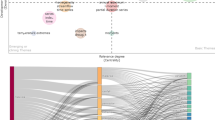Abstract
In recent years, because the frequency and severity of floods have increased across Canada, it is important to understand the characteristics of Canadian heavy precipitation. Long-term precipitation data of 463 gauging stations of Canada were analyzed using non-stationary generalized extreme value distribution (GEV), Poisson distribution and generalized Pareto (GP) distribution. Time-varying covariates that represent large-scale climate patterns such as El Niño Southern Oscillation (ENSO), North Atlantic Oscillation (NAO), Pacific decadal oscillation (PDO) and North Pacific Oscillation (NP) were incorporated to parameters of GEV, Poisson and GP distributions. Results show that GEV distributions tend to under-estimate annual maximum daily precipitation (AMP) of western and eastern coastal regions of Canada, compared to GP distributions. Poisson regressions show that temporal clusters of heavy precipitation events in Canada are related to large-scale climate patterns. By modeling AMP time series with non-stationary GEV and heavy precipitation with non-stationary GP distributions, it is evident that AMP and heavy precipitation of Canada show strong non-stationarities (abrupt and slowly varying changes) likely because of the influence of large-scale climate patterns. AMP in southwestern coastal regions, southern Canadian Prairies and the Great Lakes tend to be higher in El Niño than in La Niña years, while AMP of other regions of Canada tends to be lower in El Niño than in La Niña years. The influence of ENSO on heavy precipitation was spatially consistent but stronger than on AMP. The effect of PDO, NAO and NP on extreme precipitation is also statistically significant at some stations across Canada.










Similar content being viewed by others
References
Ahmari H, Blais E-L, Greshuk J (2015) The 2014 flood event in the Assiniboine River Basin: causes, assessment and damage. Can Water Resour J. doi:10.1080/07011784.2015.1070695
Alexander LV et al (2006) Global observed changes in daily climate extremes of temperature and precipitation. J Geophys Res 111:D05109. doi:10.1029/2005JD006290
Allan RP, Soden BJ (2008) Atmospheric warming and the amplification of precipitation extremes. Science 321:1481–1484
Blais E-L, Greshuk J, Stadnyk T (2015) The 2011 flood event in the Assiniboine River Basin: causes, assessment and damages. Can Water Resour J. doi:10.1080/07011784.2015.1046139
Bond NA, Harrison DE (2000) The Pacific decadal oscillation, air–sea interaction and central north Pacific winter atmospheric regimes. Geophys Res Lett 27:731–734
Bonsal B, Shabbar A (2008) Impacts of large-scale circulation variability on low streamflows over Canada: a review. Can Water Resour J 33:137–154
Burn DH, Taleghani A (2013) Estimates of changes in design rainfall values for Canada. Hydrol Process 27:1590–1599
Buttle JM, Allen DM, Caissie D, Davison B, Hayashi M, Peters DL, Pomeroy JW, Simonovic S, St-Hilaire A, Whitfield PH (2016) Flood processes in Canada: regional and special aspects. Can Water Resour J. doi:10.1080/07011784.2015.1131629
Cameron AC, Trivedi PK (1990) Regression-based tests for overdispersion in the poisson model. J Econom 46:347–364
Coles S (2001) An introduction to statistical modeling of extreme values. Springer, London
Coulibaly P (2006) Spatial and temporal variability of Canadian seasonal precipitation (1900–2000). Adv Water Resour 29:1846–1865
Coulibaly P, Burn DH (2005) Spatial and temporal variability of Canadian seasonal streamflows. J Clim 18:191–210
Environment Canada (2014) Canada’s top ten weather stories for 2013. http://www.ec.gc.ca/meteo-weather/default.asp?lang5En&n55BA5EAFC-1
Franzke CL (2013) Persistent regimes and extreme events of the North Atlantic atmospheric circulation. Philos Trans A Math Phys Eng Sci 371:20110471
Gan TY, Gobena AK, Wang Q (2007) Precipitation of southwestern Canada: wavelet, scaling, multifractal analysis, and teleconnection to climate anomalies. J Geophys Res 112:D10110. doi:10.1029/2006JD007157
Gilleland E, Katz RW (2011) New software to analyze how extremes change over time. Eos Trans Am Geophys Union 92(2):13–14
Government of Alberta (2014) Alberta 2013–2014 flood recovery update. http://alberta.ca/Flood-recovery-update.cfm
Groisman PY et al (1999) Changes in the probability of heavy precipitation: important indicators of climatic change. Clim Change 42:243–283
Higgins RW, Leetmaa A, Kousky VE (2002) Relationships between climate variability and winter temperature extremes in the United States. J Clim 15:1555–1572
Hurrell JW, Loon HV (1997) Decadal variations in climate associated with the North Atlantic oscillation. Clim Change 36:301–326
Jiang R, Gan TY, Xie J, Wang N (2014) Spatiotemporal variability of Alberta’s seasonal precipitation, their teleconnection with large-scale climate anomalies and sea surface temperature. Int J Climatol 34:2899–2917
Kalnay E et al (1996) The NCEP/NCAR 40-year reanalysis project. Bull Am Meteorol Soc 77:437–471
Kenyon J, Hegerl GC (2008) Influence of modes of climate variability on global temperature extremes. J Clim 21:3872–3889
Khaliq MN, Ouarda TBMJ, Ondo JC, Gachon P, Bobée B (2006) Frequency analysis of a sequence of dependent and/or non-stationary hydro-meteorological observations: a review. J Hydrol 329:534–552
Kunkel KE (2003) North American trends in extreme precipitation. Nat Hazards 29:291–305
Kunkel KE, Andsager K (1999) Long-term trends in extreme precipitation events over the conterminous United States and Canada. J Clim 12:2515–2572
Kuo C-C, Gan TY, Gizaw M (2015) Potential impact of climate change on intensity duration frequency curves of central Alberta. Clim Change 130:115–129
Kyselý J, Picek J, Beranová R (2010) Estimating extremes in climate change simulations using the peaks-over-threshold method with a non-stationary threshold. Global Planet Change 72:55–68
Mailhot A, Kingumbi A, Talbot G, Poulin A (2010) Future changes in intensity and seasonal pattern of occurrence of daily and multi-day annual maximum precipitation over Canada. J Hydrol 388:173–185
Mailier PJ, Stephenson DB, Ferro CAT (2006) Serial clustering of extratropical cyclones. Mon Weather Rev 134:2224–2240
Mallakpour I, Villarini G (2015) The changing nature of flooding across the central United States. Nat Clim Change 5:250–254
Mantua NJ, Hare SR (2002) The Pacific decadal oscillation. J Oceanogr 58:35–44
Mantua NJ, Hare SR, Zhang Y, Wallace JM, Francis RC (1997) A pacific interdecadal climate oscillation with impacts on salmon production. Bull Am Meteorol Soc 78:1069–1079
Maraun D, Rust HW, Osborn TJ (2010) Synoptic airflow and UK daily precipitation extremes. Extremes 13:133–153
Mekis E, Hogg WD (1999) Rehabilitation and analysis of Canadian daily precipitation time series. Atmos Ocean 37:53–85
Mekis É, Vincent LA (2011) An overview of the second generation adjusted daily precipitation dataset for trend analysis in Canada. Atmos Ocean 49:163–177
Milrad SM, Gyakum JR, Atallah EH (2015) A meteorological analysis of the 2013 Alberta Flood: antecedent large-scale flow pattern and synoptic-dynamic characteristics. Mon Weather Rev 143(7):2817–2841. doi:10.1175/mwr-d-14-00236.1
Min S-K, Cai W, Whetton P (2013) Influence of climate variability on seasonal extremes over Australia. J Geophys Res Atmos 118:643–654
Mladjic B, Sushama L, Khaliq MN, Laprise R, Caya D, Roy R (2011) Canadian RCM projected changes to extreme precipitation characteristics over Canada. J Clim 24:2565–2584
Muggeo VM (2003) Estimating regression models with unknown break-points. Stat Med 22:3055–3071
Newton B, Burrell BC (2015) The April–May 2008 flood event in the Saint John River Basin: causes, assessment and damages. Can Water Resour J. doi:10.1080/07011784.2015.1009950
Peterson TC, Zhang X, Brunet-India M, Vázquez-Aguirre JL (2008) Changes in North American extremes derived from daily weather data. J Geophys Res 113:D07113. doi:10.1029/2007JD009453
Pinto JG, Bellenbaum N, Karremann MK, Della-Marta PM (2013) Serial clustering of extratropical cyclones over the North Atlantic and Europe under recent and future climate conditions. J Geophys Res Atmos 118:12476–412485
Pomeroy JW, Stewart RE, Whitfield PH (2015) The 2013 flood event in the South Saskatchewan and Elk River basins: causes, assessment and damages. Can Water Resour J. doi:10.1080/07011784.2015.1089190
Rayner NA et al (2003) Global analyses of sea surface temperature, sea ice, and night marine air temperature since the late nineteenth century. J Geophys Res Atmos 108:4407. doi:10.1029/2002JD002670
Ropelewski CF, Halpert MS (1986) North American precipitation and temperature patterns associated with the El Niño/Southern Oscillation (ENSO). Mon Weather Rev 114:2352–2362
Ropelewski CF, Jones PD (1987) An extension of the Tahiti-Darwin southern oscillation index. Mon Weather Rev 115:2161–2165
Saad C, St-Hilaire A, Gachon P, El Adlouni S (2015) The 2011 flood event in the Richelieu River basin: causes, assessment and damages. Can Water Resour J. doi:10.1080/07011784.2014.999825
Seager R, Naik N, Vogel L (2012) Does global warming cause intensified interannual hydroclimate variability? J Clim 25:3355–3372
Shabbar A, Skinner W (2004) Summer drought patterns in canada and the relationship to global sea surface temperatures. J Clim 17:2866–2880
Shabbar A, Bonsal B, Khandekar M (1997) Canadian precipitation patterns associated with the Southern Oscillation. J Clim 10:3016–3207
Shang H, Yan J, Zhang X (2011) El Niño–Southern Oscillation influence on winter maximum daily precipitation in California in a spatial model. Water Resour Res 47:W11507
Shook K, Pomeroy J (2012) Changes in the hydrological character of rainfall on the Canadian prairies. Hydrol Process 26(12):1752–1766. doi:10.1002/hyp.9383
Sillmann J, Croci-Maspoli M, Kallache M, Katz RW (2011) Extreme cold winter temperatures in Europe under the influence of north Atlantic atmospheric blocking. J Clim 24:5899–5913
St. Jacques J-M, Sauchyn DJ, Zhao Y, (2010) Northern Rocky Mountain streamflow records: global warming trends, human impacts or natural variability? Geophys Res Lett 37:6. doi:10.1029/2009GL042045
St. Jacques J-M, Huang YA, Zhao Y, Lapp SL, Sauchyn DJ (2014) Detection and attribution of variability and trends in streamflow records from the Canadian Prairie Provinces. Can Water Resour J 39(3):270–284. doi:10.1080/07011784.2014.942575
Stadnyk T, Dow K, Wazney L, Blais E-L (2015) The 2011 flood event in the Red River Basin: causes, assessment and damages. Can Water Resour J 1–9. doi:10.1080/07011784.2015.1008048
Sugahara S, da Rocha RP, Silveira R (2009) Non-stationary frequency analysis of extreme daily rainfall in Sao Paulo, Brazil. Int J Climatol 29:1339–1349
Szeto K, Brimelow JC, Gysbers P, Stewart RE (2015) The 2014 extreme flood on the southeastern Canadian prairies. Bull Am Meteorol Soc 96(12):520–552
Tramblay Y, Neppel L, Carreau J, Najib K (2013) Non-stationary frequency analysis of heavy rainfall events in southern France. Hydrolog Sci J 58:280–294
Trenberth KE (1997) The definition of El Niño. Bull Am Meteorol Soc 78:2771–2777
Trenberth KE, Hurrell JW (1994) Decadal atmosphere-ocean variations in the Pacific. Clim Dyn 9:303–319
Villarini G, Smith JA, Baeck ML, Vitolo R, Stephenson DB, Krajewski WF (2011) On the frequency of heavy rainfall for the Midwest of the United States. J Hydrol 400:103–120
Villarini G, Smith JA, Serinaldi F, Ntelekos AA, Schwarz U (2012) Analyses of extreme flooding in Austria over the period 1951–2006. Int J Climatol 32:1178–1192
Villarini G, Smith JA, Vecchi GA (2013) Changing frequency of heavy rainfall over the central United States. J Clim 26:351–357
Vincent LA, Mekis É (2006) Changes in daily and extreme temperature and precipitation indices for Canada over the twentieth century. Atmos Ocean 44:177–193
Wazney L, Clark SP (2015) The 2009 flood event in the Red River Basin: causes, assessment and damages. Can Water Resour J. doi:10.1080/07011784.2015.1009949
Wilks DS (2006) On “field significance” and the false discovery rate. J Appl Meteorol Clim 45:1181–1189
Zhang X, Vincent LA, Hogg WD, Niitsoo A (2000) Temperature and precipitation trends in Canada during the 20th century. Atmos Ocean 38:395–429
Zhang X, Hogg WD, Mekis É (2001) Spatial and temporal characteristics of heavy precipitation events over Canada. J Clim 14:1923–1936
Zhang X, Wang J, Zwiers FW, Groisman PY (2010) The influence of large-scale climate variability on winter maximum daily precipitation over North America. J Clim 23:2902–2915
Acknowledgments
The authors thank the two anonymous reviewers for their constructive suggestions which significantly improved the paper. The first author was partly funded by the Chinese Scholarship Council (CSC) of China, and by the University of Alberta. We are grateful to Éva Mekis from Climate Research Division Environment Canada for providing us the precipitation data use in this study.
Author information
Authors and Affiliations
Corresponding author
Electronic supplementary material
Below is the link to the electronic supplementary material.
Appendices
Appendix 1: GEV distribution
Let M = max {Z 1,…, Z n } for large n, where Z 1, Z 2,… is a sequence of independent (or weakly dependent) identically distributed observations. In this study, Z t represents daily observed precipitation recorded at a particular station on day t, and M is the AMP. Asymptotic results state that under some regularity conditions, normalizing sequences{a n } and {b n > 0} can be found such that (Coles 2001):
as n → ∞, for a non-degenerate distribution function, which is the GEV distribution with the cumulative distribution function:
where 1 + ξ(y − μ)/σ > 0, μ, σ and ξ are the location, scale, and shape parameters, respectively. The shape parameter ξ determines the type of tail behavior. ξ < 0, ξ = 0 and ξ > 0 correspond to the Weibull (Type III), Gumbel (Type I) and Fréchet (Type II) distributions, respectively.
For a non-stationary process, the time-varying GEV parameters can be estimated by time-varying covariates. For instance, the GEV location parameter is defined through a linear function of covariates:
where X = (1, x 1,…, x m ) is a matrix of the time-varying covariate vectors x 1,…, x m , β = (β 0, β 1, …β m ) is the parameter vector to be estimated, in which β 0 is the intercept and β 1,…β m are the regression coefficients for the corresponding covariates; m is the number of covariates considered. The scale and shape parameters of the GEV distribution can be similarly expressed as Eq. (3).
Appendix 2: Poisson regression
The numbers of days (counts) of extreme values exceeding a threshold over a specified time interval (a year in this study) can be modeled by a Poisson distribution with an equal-dispersion (the mean equals the variance). However, the variance of observed data tends to be larger than the mean, known as over-dispersion, which can partly be attributed to the effect of temporal clustering (Mallakpour and Villarini 2015; Pinto et al. 2013; Villarini et al. 2011, 2013). The statistical significance of dispersion coefficients different from unity at 5 % significance level can be tested using the regression-based tests (Cameron and Trivedi 1990) for testing over-dispersion in a Poisson model.
A Poisson regression models discrete data, in which the predict and follows a Poisson distribution. The counts in year i as N i have a conditional Poisson distribution with the rate of occurrence parameter λ i , given that:
where λ i is a non-negative random variable. In a Poisson regression model, λ i can be modeled as a function of predictors x 1i , x 2i ,…, x mi in a manner similar to parameters of a non-stationary GEV (see Eq. 3):
where β j is the coefficient for the j-th predictor (x ji ) estimated by the maximum likelihood method. If β j estimated is non-zero at a 5 % significance level, then there is a statistically significant relationship between the occurrence of extreme events and the predictor x j . By relating λ i to the time using an exponential function λ i = exp (β 0 + β 1 i), changes in the mean number of occurrences of heavy precipitation with time can be examined. If β 1 is non-zero at the 5 % significance level, temporal changes in the mean number of extreme events are statistically significant (Villarini et al. 2011, 2012, 2013). The abrupt change points of the occurrences of extreme events can be further identified by a segmented regression in which the relation between the predictand and the predictor is piecewise linear. We used the function segmented in the R package ‘segmented’ (Muggeo 2003) to detect change points and to estimate β 0 and β 1 for the Poisson regression model.
Appendix 3: GP distribution
The exceedance, Q = Z – u (where Z is the observed precipitation and u the threshold) can be modeled as a GP distribution (Coles 2001):
For q ≥ 0 and 1 + ξq/σ > 0, where σ and ξ are the scale and shape parameters of a GP distribution. For ξ = 0, GP reduces to an exponential distribution. The GP distribution can be set up to model non-stationary processes, usually by making the scale parameter σ depend on particular covariate(s) (Coles 2001; Khaliq et al. 2006). The log of σ is regressed against covariates X, log (σ) = βX, as shown in Eqs. 3 and 5.
The return level y l is exceeded on average l times over a fixed period. Since there are on average λ peaks in the whole time series, the probability that an arbitrary peak exceeds y l equals l/λ. Thus, y l is obtained by adding the threshold to the (1 − l/λ) quantile of the excess distribution (Coles 2001):
For presentation, it is often more convenient to give return levels on an annual scale, so that the N-year return level is the level expected to be exceeded once every N years.
Appendix 4: The likelihood-ratio test
The likelihood-ratio test can compare results obtained from GEV and GP distributions of parameters expressed with covariates of various complexities, such that the base covariate (e.g., M 0) is a subset of a more complex covariate (e.g., M 1). The likelihood-ratio test can determine which sets of model parameters will lead to the overall best model performance for GEV and GP. Suppose a base model M 0 is nested within a model M 1, and L 0 (L 1) is the negative log-likelihood value for M 0 (M 1), then a deviance statistics is given by (Coles 2001):
Large values of D indicate that M 1 is more adequate for representing the data than its base counterpart M 0. The D statistic follows a Chi square distribution with degree of freedom, ν (difference between the number of parameters of the models M 0 and M 1). D α is the (1 − α) quantile of the Chi square distribution at the α significant level. The null hypothesis D = 0 is rejected if D > D α . We used functions in the R package ‘extRemes’ (Gilleland and Katz 2011) for inferring the parameters of GEV and GP distributions and testing the significance of the relations between parameters and covariates.
Rights and permissions
About this article
Cite this article
Tan, X., Gan, T.Y. Non-stationary analysis of the frequency and intensity of heavy precipitation over Canada and their relations to large-scale climate patterns. Clim Dyn 48, 2983–3001 (2017). https://doi.org/10.1007/s00382-016-3246-9
Received:
Accepted:
Published:
Issue Date:
DOI: https://doi.org/10.1007/s00382-016-3246-9




